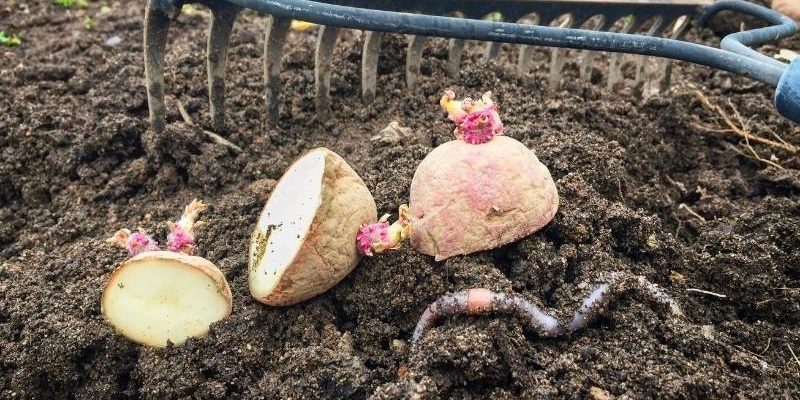Potatoes are among the easiest crops to cultivate, but they are typically grown by planting pieces of the root system, known as “seed potatoes,” as opposed to the seeds produced by the plant’s flowers. Potatoes grow more efficiently through vegetative multiplication than from seed, and it is also easier for most amateur gardeners. When a home gardener digs into a bag of freshly dug potatoes, they are in for a real treat. However, your potato crop will be more successful if you plant seed potatoes first. Growing your own seed potatoes is simple and inexpensive, but there are a few things to keep in mind before planting your first crop. Potatoes are a staple ingredient in numerous cuisines, particularly western cuisines such as British and Scandinavian. The world’s greatest chefs each have a signature potato dish in their most renowned restaurants.Read more about the Best Celebrity Chefs and their restaurants over at Slingo.com
Choosing A Spud
While grocery stores typically stock only a handful of potato varieties, gardeners can choose from over a hundred distinct varieties of seed potatoes. It is prudent to investigate which varieties of potatoes thrive best in your region and possess the qualities and flavors you prefer. Potato seed is only as good as its origin. It may appear to be a good idea to purchase seed potatoes from a local supermarket. These potatoes, however, have been chemically treated to prevent germination and have not been inspected for common seed potato infections. You must select a trustworthy seed potato vendor in order to obtain tubers. These stores will sell seed potatoes that have been treated to resist bacterial and fungal growth. Some gardeners store potato seeds for future use. You should attempt this at your own peril. If you are unable to examine seed potatoes as thoroughly as commercial seed companies can, your entire crop could be at risk if the seed potatoes are infected with soil-borne diseases. Planting seed potatoes requires disease-free, freshly harvested tubers. These can be found in garden shops or ordered online from specialized stores that carry uncommon varieties.
Preparation
When starting a new potato crop, it is important to choose seeds that have been bred specifically for the growing conditions. Furthermore, they ought to have a natural appearance. There is no way to tell if the ones from the grocery store were grown organically or sprayed with a harmful chemical because there is no way to verify this information. Constructing a bed that gets seven to eight hours of direct sunlight per day is recommended in the event that unanticipated rainfall makes digging difficult at your location. To aid in loosening and strengthening the clay soil, incorporate a small amount of organic fertilizer and some compost into the mix. In order to get seed potatoes ready for planting, chop them up into pieces that are about the size of an egg. Each of these pieces should have at least one “eye” on it. If you don’t give them time to dry out for at least a couple of days after you cut them, they will rot in the cool and moist soil if you don’t give them a chance to do so first. It is not recommended to trim potatoes prior to planting them. If the homeowner gardener decides to prune them or not, the decision is entirely up to them. If you cut your seed potatoes, you might get a little more use out of them and grow more potatoes, but you also increase the risk of infection and rot in the potatoes by doing so. If you decide to cut your seed potatoes, each piece should weigh about one ounce and contain at least one eye. If you choose not to cut them, leave them whole. The seed potatoes should be stored in a location that is cool and moist for approximately two to three days. In addition, now is a good time to apply antifungal powder to the sliced seed potatoes. This should be done as soon as possible. They should be planted as soon as possible after the curing process has been completed.
Soil Method
The planting of seed potatoes at the appropriate time is essential. When seed potatoes are planted in soil that is too cold and wet, there is a possibility that the potatoes will rot. On the other hand, planting seed potatoes in soil that is too warm will cause the potatoes’ growth to be stunted. After the danger of a severe frost has passed, but while light frosts are still common, plant seed potatoes. If you live in an area that experiences significant shifts in temperature from hot to cold throughout the year, chitting seed potatoes is an excellent way to get a head start on the year. It is recommended that the seed potatoes be planted at a depth of two to three inches (five to seven centimeters) and at a distance of one meter (60 cm). There is no need for alarm in the event that a light frost kills any new growth that has emerged above the soil. The potato plant cannot be killed, and it will continue to produce new leaves at a rapid rate.
Straw Method
After you have prepared a garden plot or raised bed in the soil, plant your potato seedlings in the straw that you have placed in the bed. The next step is to dig a hole for each seed potato that is approximately one inch deep. Some gardeners who use straw to sow seed potatoes scatter the straw across the top of the soil rather than burying it. This is done to prevent the straw from rotting in the soil. After that, place a layer of loose straw that is between 5 and 6 inches thick on top of the potato pieces. When the plants reach a depth of 8 to 10 inches, excluding the top leaves, straw should be added to the top of the bed. This should be done as the plants continue to grow. Even though straw makes an excellent mulch, you still need to water the bed on a consistent basis throughout the growing season. At the conclusion of the planting period, two weeks after the mature potato plants have died, the straw should be removed, and the tubers should be harvested. Simple as that! When planting potatoes in a garden bed, using straw as a planting medium is an effective method.
Harvesting
After three months, you can harvest “fresh” small potatoes, but you should wait until the tubers have turned yellow before harvesting large potatoes. “Fresh” small potatoes can be harvested after three months. After roughly four months, depending on the length of the season, you can prune the plants and leave the potatoes in the ground to allow the skin to harden. This should be done so that you can harvest the potatoes. After you have dug the potatoes up, instead of washing them, please just shake them to remove any excess soil. Any potatoes that are not going to be consumed right away should be placed in an area that is cool, dark, and dry. Additionally, they should be checked every few days to ensure that they have not gone bad. If you follow these fundamental steps when harvesting and planting seed potatoes, you should have a bountiful crop of potatoes for your next dish. Potatoes are very versatile and can be used in a wide variety of dishes.







Comments